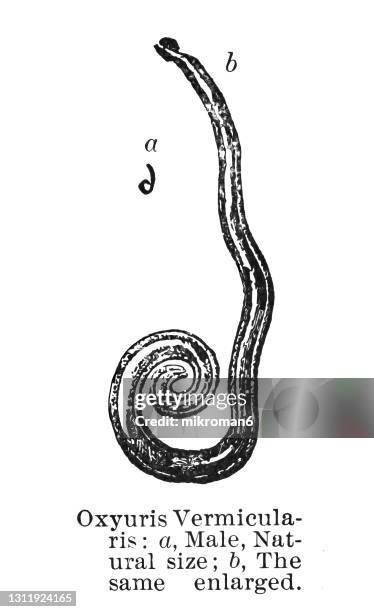
Imagine pinworms as a small snack in a vast ecosystem. Just like how a fast-food burger doesn’t just sit on the counter, waiting to be eaten—it’s subjected to all sorts of external factors. Whether it’s a hungry bird or changing environmental conditions, the pinworm population has to navigate a world that’s often out to get it. So, let’s dive into the intriguing world of pinworms and explore their predators, environmental threats, and how these factors impact their survival.
What Are Pinworms?
Before we jump into the threats pinworms face, let’s talk a bit about what these critters actually are. Pinworms, scientifically known as *Enterobius vermicularis*, are tiny parasitic worms that primarily inhabit the intestines of humans. They’re most common in children but can affect anyone. *You might be wondering, how do they even get into our bodies?* Well, pinworms spread through eggs that are often not visible to the naked eye. When someone scratches their itchy bottom, the eggs can get transferred to fingers and surfaces, and then into other people’s mouths. Yuck, right?
These worms can cause discomfort and distress, leading to itching and sometimes sleep disruption. The typical life cycle of a pinworm involves laying eggs around the anus, which hatch and grow, giving rise to new adult worms. They prefer living in a warm environment, which is why the human intestines are their home sweet home.
But what about their life outside the human body? When they’re laid as eggs in the environment, they are incredibly resilient. However, they are also vulnerable to certain predators and environmental conditions that can dramatically affect their numbers.
Natural Predators of Pinworms
Just like any other critter, pinworms have their foes. While you may think of predators as larger animals, in the case of pinworms, it’s often smaller creatures that play this role. Think about this: You’re a tiny worm in a big world, and there are all sorts of bugs and microorganisms hunting you down.
Some of the primary predators of pinworms include:
- Soil Nematodes: These small roundworms can feed on other nematodes, including pinworms. They are like the mini-sharks of the soil, swimming through it and snacking on anything in their path.
- Fungal Pathogens: Certain fungi can infect and kill pinworms, breaking down their bodies and recycling nutrients back into the soil. You might think of these fungi as the cleanup crew, ensuring that pinworm populations don’t get too large.
- Bacteria: Some bacteria can also impact the survival of pinworm eggs. They can either directly kill the eggs or outcompete them for resources.
Honestly, it’s a tough world out there for pinworms. Just because they can thrive in humans doesn’t mean they’re safe in the soil or other environments.
Environmental Conditions That Threaten Pinworm Populations
Apart from predators, environmental conditions also play a crucial role in pinworm survival. Various changes in their habitat can directly affect how many pinworms can thrive. Here are a couple of significant factors:
- Temperature: Pinworm eggs have a specific temperature range in which they thrive. Extreme cold or heat can kill the eggs, making it difficult for pinworm populations to increase.
- Moisture Levels: Like many organisms, pinworms need certain moisture levels to survive. Excessive dryness can make the environment less hospitable for them, while too much moisture can lead to their eggs being washed away.
These environmental factors act like a double-edged sword. While they can help regulate pinworm populations, they also make life more challenging for them. It’s a balancing act, and any significant change can tip the scales.
Human Impact on Pinworm Populations
Human activities can also have a significant impact on pinworm populations. As we alter our environments, we’re inadvertently affecting these tiny creatures. Here’s how:
- Sanitation Practices: Good hygiene practices can drastically reduce pinworm populations. Regular handwashing, keeping living spaces clean, and proper disposal of waste can keep these parasites in check.
- Use of Chemicals: Pesticides and other chemicals can affect not only the pests we’re trying to eliminate but also pinworms and their eggs. This can disrupt their lifecycle dramatically.
It’s fascinating to think that our daily habits and choices can ripple out to impact even the smallest of creatures. By practicing good hygiene and being mindful of chemical usage, we can help control pinworm populations without unnecessary harm.
Pinworms and Their Resilience
Despite all these challenges, pinworms have managed to survive for centuries. Their tenacity is impressive. They have developed strategies to adapt to their environment and continue their lifecycle. This resilience is a testament to how evolution shapes species over time.
For example, pinworm eggs can survive outside a host for several weeks, waiting for the right opportunity to infect. This dormancy allows them to withstand unfavorable conditions and ensures the species doesn’t easily die out.
Moreover, pinworms have a surprisingly high reproductive rate, with a single female laying thousands of eggs. This reproductive strategy ensures that even if many eggs get lost to predators or environmental factors, enough will survive to continue the population.
So, there you have it! Pinworms lead a life filled with challenges, from natural predators to changing environmental conditions. While they may be a nuisance to humans, they also play a role in the ecosystem. Understanding the threats they face helps us appreciate the delicate balance of nature.
The next time you think about pinworms, maybe you’ll consider not just their impact on humans but also the fascinating world they inhabit. Life is complex, and every creature, no matter how small, has a story worth telling. By keeping our environments clean and promoting good health practices, we not only protect ourselves but also play a part in the broader ecosystem. Isn’t that something to think about?

